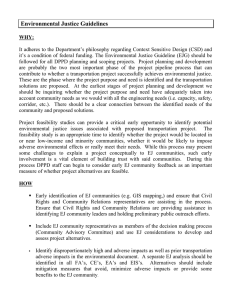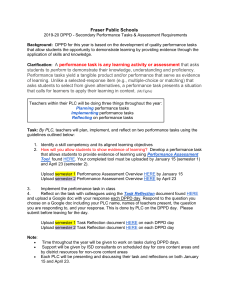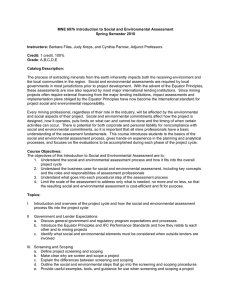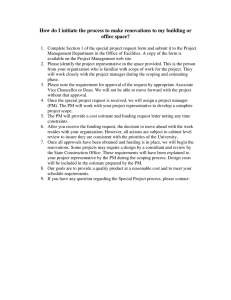Scope Team Meeting:
advertisement
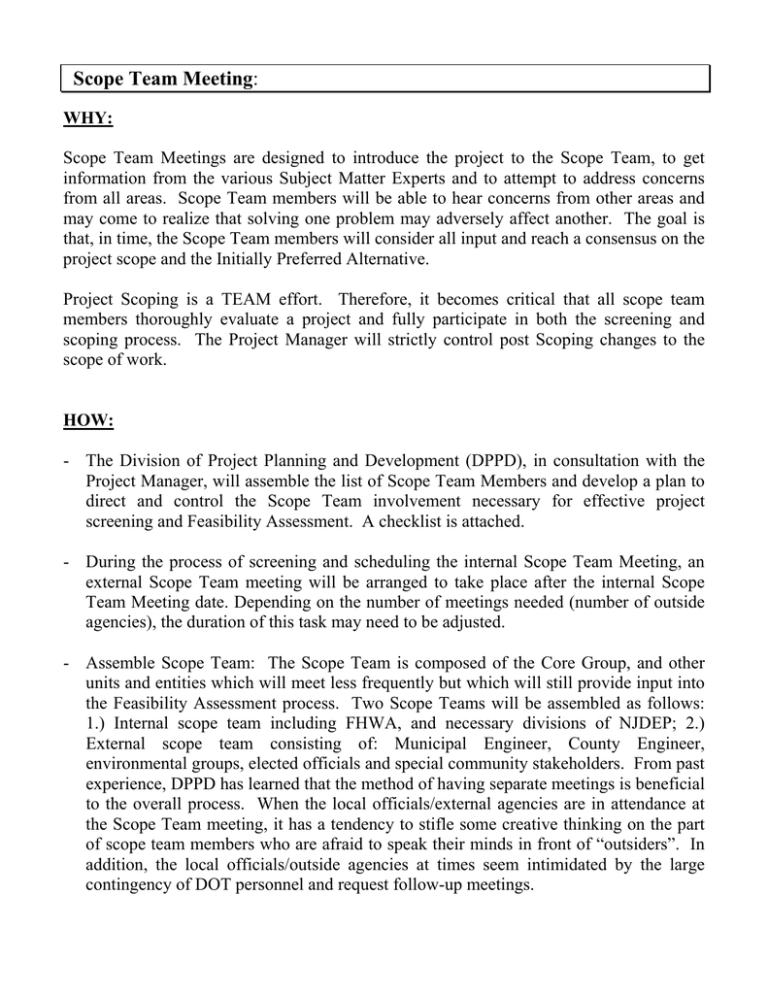
Scope Team Meeting: WHY: Scope Team Meetings are designed to introduce the project to the Scope Team, to get information from the various Subject Matter Experts and to attempt to address concerns from all areas. Scope Team members will be able to hear concerns from other areas and may come to realize that solving one problem may adversely affect another. The goal is that, in time, the Scope Team members will consider all input and reach a consensus on the project scope and the Initially Preferred Alternative. Project Scoping is a TEAM effort. Therefore, it becomes critical that all scope team members thoroughly evaluate a project and fully participate in both the screening and scoping process. The Project Manager will strictly control post Scoping changes to the scope of work. HOW: - The Division of Project Planning and Development (DPPD), in consultation with the Project Manager, will assemble the list of Scope Team Members and develop a plan to direct and control the Scope Team involvement necessary for effective project screening and Feasibility Assessment. A checklist is attached. - During the process of screening and scheduling the internal Scope Team Meeting, an external Scope Team meeting will be arranged to take place after the internal Scope Team Meeting date. Depending on the number of meetings needed (number of outside agencies), the duration of this task may need to be adjusted. - Assemble Scope Team: The Scope Team is composed of the Core Group, and other units and entities which will meet less frequently but which will still provide input into the Feasibility Assessment process. Two Scope Teams will be assembled as follows: 1.) Internal scope team including FHWA, and necessary divisions of NJDEP; 2.) External scope team consisting of: Municipal Engineer, County Engineer, environmental groups, elected officials and special community stakeholders. From past experience, DPPD has learned that the method of having separate meetings is beneficial to the overall process. When the local officials/external agencies are in attendance at the Scope Team meeting, it has a tendency to stifle some creative thinking on the part of scope team members who are afraid to speak their minds in front of “outsiders”. In addition, the local officials/outside agencies at times seem intimidated by the large contingency of DOT personnel and request follow-up meetings. - DPPD will carefully arranging Scope Team Meetings so that all “stakeholders” are represented; however, care must be taken to ensure that an excessively large group is not assembled. Unnecessarily large groups inhibit effective communication and drive up soft costs. The DPPD will also need to break down the Team as soon as its usefulness has ended. - Each member of the internal Scope Team will be provided a Project Fact Sheet and other relevant information such as traffic data, accident data, environmental data, a description of the concept and any other information necessary to understand the project need and intent prior to convening the scope meeting. - It is the individual Scope Team member’s responsibility to thoroughly analyze the project and to be fully prepared to discuss issues within their jurisdiction at the scope meeting. Scope Team members will have to arrange and take a field trip to the site, evaluate the data on the project fact sheet and be prepared to provide good input at the up-coming Scope Team Meeting. All Scope Team members shall utilize their individual unit’s Project Scoping Checklist (as per the procedures manual), and bring their checklist with written comments to the meeting. - The following is a list of possible items that will be discussed at the internal scope meeting: Project Need Potential Alternatives Project Limits - approximate, with mileposts Existing Construction Plans and Right of Way Documents Survey Control Posted/Design Speeds Traffic Data and operational needs Crash Data Project Category - reconstruction, 3R, etc. Design Standard - NJDOT Design Manuals, etc. Lane/Shoulder widths Border widths/Right of Way Median widths Cross slope/Superelevation Horizontal/Vertical Geometry Sight Distance - horizontal, vertical and intersection Curb (type and size)/Sidewalks Mobility - bikes, pedestrians, handicapped facilities, etc. Existing/Proposed Pavement Traffic Barriers Drainage features Landscaping Signals/Signing/Lighting/Striping Interchange/Intersection configurations ITS Facilities Structural clearances - horizontal, vertical Proposed Structural needs, including clearances (horizontal, vertical) and deck deficiencies that need to be addressed, etc. Bridge approaches and railings Structural physical condition (from inspection report) Structural profile/geometry Walls Waterway openings Environmental constraints - permit requirements, who will get the permits?, etc. Environmental Justice (EJ) Noise requirements - should a study be done? Local Commitments/Public Involvement Maintenance features Traffic Control (including nightwork) Jurisdiction Utilities/Railroads Access Constructibility - traffic control, detours, temporary signals, etc. QA/QC Guidelines - At the internal scope meeting, supervised by the DPPD, the scope team shall utilize the items listed above, along with information from the NJDOT GIS system and the most recent road and/or bridge plans and videolog, if available. If deemed necessary, the Bureau of Environmental Support Services will provide information as to the proximity of major wetlands, potential cultural resources, significant hazardous sites, Green Acres properties, etc. - The Scope Team Meeting will be documented with a memorandum of record and entered into the project file.
